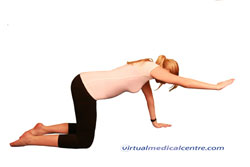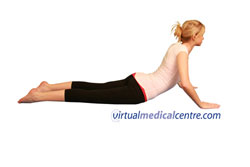- Introduction to yoga during pregnancy
- Why do yoga?
- Benefits of yoga
- Before you start
- Workout tips
- In summary
Introduction to yoga during pregnancy
Yoga is quickly becoming a popular activity amongst expectant mothers. The gentle movements and breathing exercises help to develop ways to cope with and reduce stress, and improve on prenatal classes, which now often do not cover the breathing changes experienced during childbirth. The ‘inward focus’ that yoga encourages also helps the mother to connect emotionally with her unborn child. These lead to a smoother time throughout pregnancy and birthing.
Why do yoga?

Yoga is a safe and effective way to reduce the stresses faced during pregnancy, through different postures, breathing techniques, meditation or chanting. The techniques of yoga not only help with the calm progress through pre-natal stages and birth, it also assists in preventing the stresses after birthing. This includes calmer interaction with the new baby, preventing sleep deprivation and other stressful situations created by a newborn, as well as assisting the mother return to her pre-birth figure.
Benefits of yoga
Stretching postures help to reduce muscle tension and improve joint flexibility, while the fast, shallow breathing that occurs during pregnancy can be slowed with through controlled breathing exercises. It is these characteristics which lead to the development of the techniques taught in childbirth classes. Yoga can help to reduce the fatigue and minor pains of pregnancy and assist blood circulation. The relaxation techniques learned can also be used during and after labour. Women who perform yoga during their pregnancy have been found to have significantly less preterm deliveries, low birth weights and intrauterine growth retardation and a trend towards less pregnancy induced hypertension (high blood pressure), when compared to women who did aerobic exercise twice a day.
One of the main realisations one can have from regular yoga practise, is that stress and sweat are not the only ways to fitness. Yoga provides a gentle but strong way to maintain fitness and flexibility. This isn’t to suggest that yoga should replace aerobic or any other forms of exercise, but that it should be included along with these other activities to maintain (or improve) the health of both mother and child throughout and after pregnancy.
Before you start

Not all yoga positions and movements can be performed safely while pregnant, with particular reason to be careful in the first 12 weeks. As such, it is recommended that those who have not done any yoga before pregnancy do not start until after the first 12 weeks has been reached.
Every pregnancy is different, so no matter how long you have been doing yoga, it is imperative that you obtain a doctor’s certificate to stating that you are safely able to maintain yoga practice throughout the pregnancy, when you can start, and anything that should be avoided. A doctor’s certificate from each pre-natal student/patient is mandatory for the yoga instructor, at least for insurance purposes.
Be sure that you seek a qualified instructor, preferably one who is experienced in yoga during pregnancy. It is up to the client/patient to check that their instructor is trained and registered. Look for someone who is trained at least to RYTA200 standard, (and preferably a trained yoga therapist with IYTA qualifications), registered with a Yoga Association and insured with Professional Indemnity insurance as well as Public Liability and with a reputable Insurance Company. There are self-regulatory yoga associations in each state and excellent yoga teacher training schools that can point you in the right direction.
Workout tips
There are many beneficial pre-natal poses in yoga that require the new mum to lie on her back. However, from three months onwards, activities that involve lying on your back may interfere with your own circulation, due to the weight of the baby. By not spending long periods of time lying down, and using various bolsters, cushions, blankets and other props and supports provided in yoga classes, maximum comfort and safety can be maintained.
Other important tips include:
- Avoid holding your breath, as this can lead to changes in blood pressure or oxygen levels.
- Only perform stretches to the point where you can feel resistance. During pregnancy, the body releases a hormone called relaxin, which makes all joints in body more flexible and loose, and thus more easily damaged during this time.
- If you feel any unusual pain or dizziness, stop the session immediately.
- Reduce your general exercise level if you find yourself experiencing shortness of breath or excessive tiredness.
- Avoid any positions which could lead to you falling, as even mild knocks can be serious to the foetus.
- Be sure not to stand up too quickly from sitting or lying down, to prevent you from losing blood flow to your head.
- Regularly change positions, as standing for long periods without much motion can also be bad for circulation.
- Wear loose clothes to prevent discomfort and overheating.
- A warm environment can assist a gentle workout, but it is important that the body not be made to hot or cold. Extremes in temperature, especially heat, can have negative affects on the foetus.
- Drink water regularly to prevent dehydration, which will also help to prevent overheating.
In summary

(Kindly reviewed by Rev Jahne Hope Williams; Experienced Nurse; Director of Tone N Go Yoga and Nurse Editorial Advisory Board Member of the Virtual Renal Centre.)
More information
 |
For more information about pregnancy and exercise, including pre-pregnancy exercise, suitable types of exercise, risks and benefits of exercise and exercise myths, see Pregnancy and Exercise. |
 |
For more information about pregnancy, including preconception advice, stages of pregnancy, investigations, complications, living with pregnancy and birth, see Pregnancy. |
 |
For more information on fitness and exercise, including stretches, types of exercise, exercise recovery and exercise with health conditions, as well as some useful videos, see Fitness |
References
- Mulder E, Robles de Medina P, Huizink A, Van den Bergh B, Buitelaar J, & Visser G (2002). Prenatal maternal stress: effects on pregnancy and the (unborn) child. Early Human Development, 70, 3-14.
- Collins C (1998). Yoga: intuition, preventative medicine and treatment. Journal of Obstetric, Gynecologic, and Neonatal Nursing, 27(5), 563-568.
- Schaeffer R (2002). When pregnant, feel good with yoga. Natural Health, 32(8), 52-53.
- Narendran S, Nagarathna R, Narendran V, Gunasheela S, & Nagendra R (2005). Efficacy of yoga on pregnancy outcome. Journal of Alternative and Complementary Medicine, 11(2), 237-244.
- (1998). Exercise during pregnancy. American Family Physician, 57(8), 1857.
All content and media on the HealthEngine Blog is created and published online for informational purposes only. It is not intended to be a substitute for professional medical advice and should not be relied on as health or personal advice. Always seek the guidance of your doctor or other qualified health professional with any questions you may have regarding your health or a medical condition. Never disregard the advice of a medical professional, or delay in seeking it because of something you have read on this Website. If you think you may have a medical emergency, call your doctor, go to the nearest hospital emergency department, or call the emergency services immediately.








